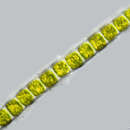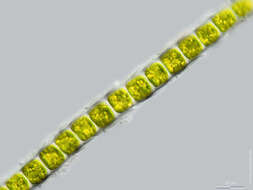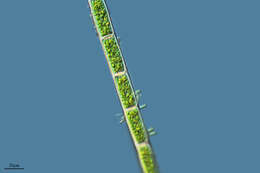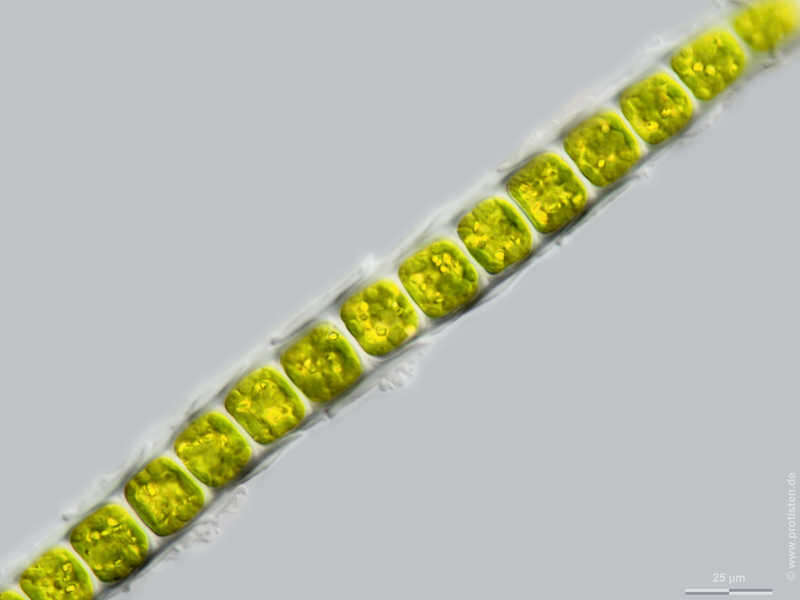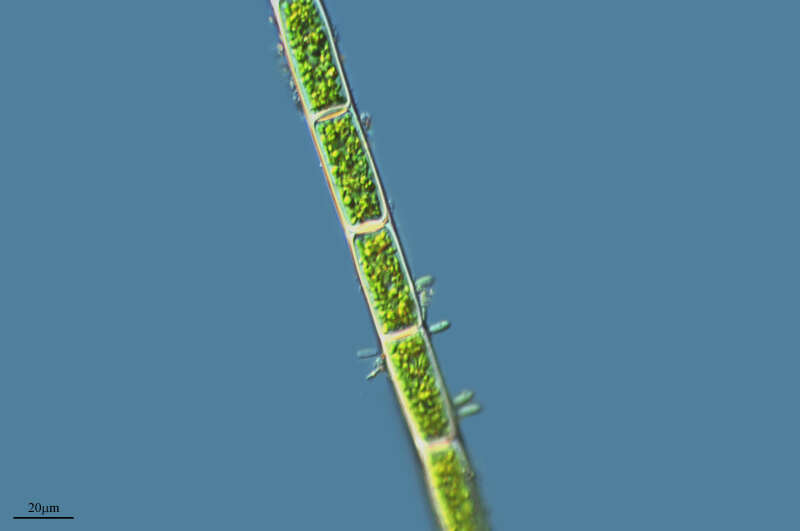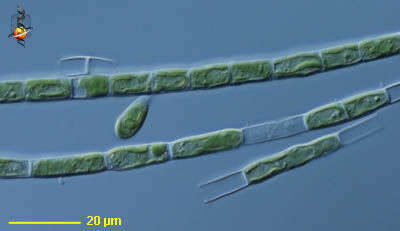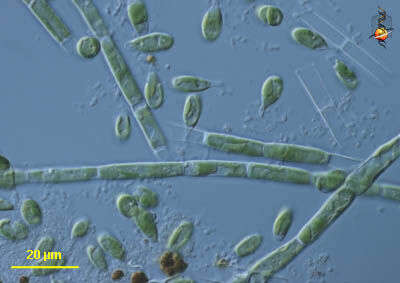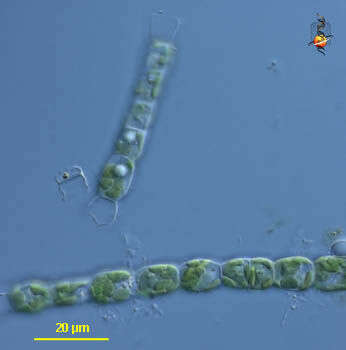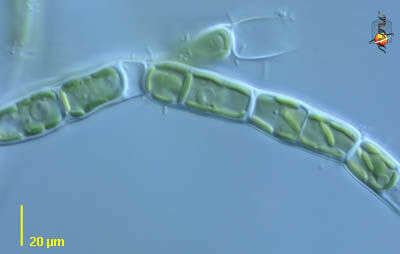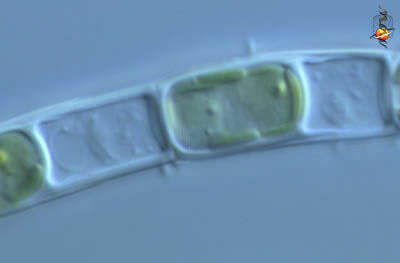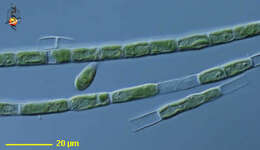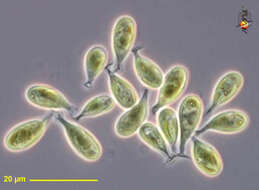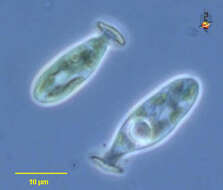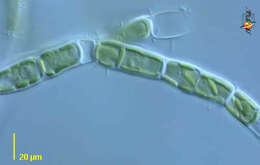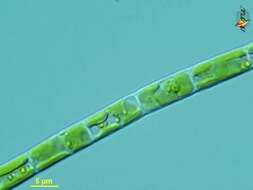-
Bumilleria sicula Scale bar indicates 25 µm. Sample from Kaltenhof Bog in the north of Kiel, Germany. Sampling date 6/2018. The image was built up using several photomicrographic frames with manual stacking technique. Images were taken using Zeiss Axioplan with Olympus OM-D M5 MKII. Image under Creative Commons License V 3.0 (CC BY-NC-SA). Place name: Bog Kaltenhof near Kiel (Schleswig-Holstein, Germany) Latitude: 54.42102744 Longitude: 10.07686615 Multiebenen-Abbildung, manuell gestapelt. Der Messbalken markiert eine Länge von 25 µm. Probe aus dem Kaltenhofer Moor nördlich von Kiel. Datum der Aufsammlung: 6/2018. Mikrotechnik: Zeiss Axioplan, Kamera: Olympus OM-D M5 MKII. Creative Commons License V 3.0 (CC BY-NC-SA). For permission to use of (high-resolution) images please contact postmaster@protisten.de.
-
Aiguaviva, Catalonia, Spain
-
Tribonema (tribe-owe-knee-ma) is a xanthophyte, a group of stramenopiles with chloroplasts. Xanthophytes may adopt a variety of body forms, and the normal form for this genus is the filament. Cell walls often built from H-shaped units, and these overlap in the middle of a cell. Stalked attached cells also occur, as is evident here. Plastids usually discoid, yellow green. Differential interference contrast.
-
Tribonema (tribe-owe-knee-ma) is a xanthophyte, a group of stramenopiles with chloroplasts. Xanthophytes may adopt a variety of body forms, and the normal form for this genus is the filament. Cell walls often built from H-shaped units, and these overlap in the middle of a cell. Stalked attached cells also occur, as is evident here. Plastids usually discoid, yellow green. Differential interference contrast.
-
Tribonema (tribe-owe-knee-ma) is a xanthophyte, a group of stramenopiles with chloroplasts. Xanthophytes may adopt a variety of body forms, and the normal form for this genus is the filament. Cell walls often built from H-shaped units, and these overlap in the middle of a cell. Stalked attached cells also occur, as is evident here. Plastids usually discoid, yellow green. Phase contrast
-
Tribonema (tribe-owe-knee-ma) is a xanthophyte, a group of stramenopiles with chloroplasts. Xanthophytes may adopt a variety of body forms, and the normal form for this genus is the filament. Cell walls often built from H-shaped units, and these overlap in the middle of a cell. Plastids usually discoid, yellow green. Differential interference contrast.
-
Tribonema (tribe-owe-knee-ma) is a xanthophyte, a group of stramenopiles with chloroplasts. Xanthophytes may adopt a variety of body forms, and the normal form for this genus is the filament. Plastids usually discoid, yellow green. Phase contrast.
-
Tribonema (tribe-owe-knee-ma) is a xanthophyte, a group of stramenopiles with chloroplasts. Xanthophytes may adopt a variety of body forms, and the normal form for this genus is the filament. Cell walls often built from H-shaped units, and these overlap in the middle of a cell. Stalked attached cells also occur, as is evident here. Plastids usually discoid, yellow green. Phase contrast.
-
Tribonema (tribe-owe-knee-ma) is a xanthophyte, a group of stramenopiles with chloroplasts. Xanthophytes may adopt a variety of body forms, and the normal form for this genus is the filament. Cell walls often built from H-shaped units, and these overlap in the middle of a cell, as is evident here. Plastids usually discoid, yellow green. Phase contrast
-
Tribonema (tribe-owe-knee-ma) is a xanthophyte, a group of stramenopiles with chloroplasts. Xanthophytes may adopt a variety of body forms, and the normal form for this genus is the filament. Cell walls often built from H-shaped units, and these overlap in the middle of a cell as can be seen here. Plastids usually discoid, yellow green. Differential interference contrast.
-
Tribonema (tribe-owe-knee-ma) is a xanthophyte, a group of stramenopiles with chloroplasts. Xanthophytes may adopt a variety of body forms, and the normal form for this genus is the filament. Plastids usually discoid, yellow green. Dark ground illumination.
-
Tribonema (try-bow-knee-ma) aequale, a xanthophyte alga which forms filaments. Plastids visible in this image. Differential interference microscopy.
data on this strain.

